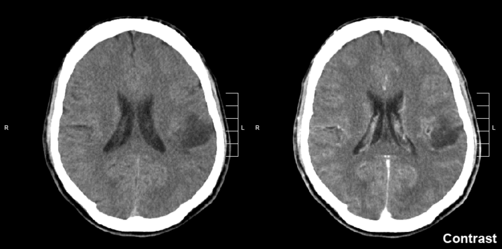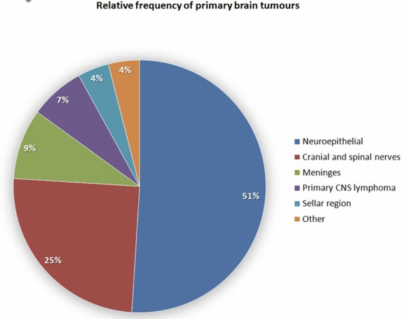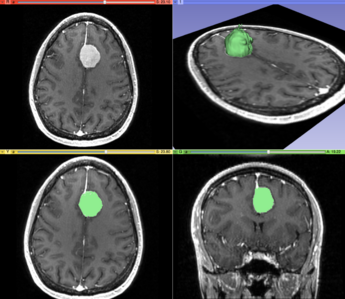Brain Tumors
Introduction[edit | edit source]
Brain tumours refers to a diverse group of neoplasms originating from intracranial tissues and the meninges with malignancy levels ranging from benign to aggressive.
Each tumour type has its own biology, treatment, and prognosis and risk factors.[1]
More than 50 per cent are malignant with poor prognosis despite surgery, radiotherapy, and chemotherapy [2]. Even benign or low -grade brain tumors can cause significant disabiity[3].
Epidemiology[edit | edit source]
Brain tumours increase in frequency with age, with a few notable exceptions and some uncommon tumours found in infancy.
Sex differences:
- Gliomas are more frequent in men
- Meningiomas are more frequent in women.[4]
Apart from genetic tendency, the largest environmental risk factor for brain tumours is exposure to high doses of ionising radiation.[1]
Classification[edit | edit source]
Brain tumour is an umbrella term for numerous individual tumours. Note figures shown vary significantly dependant on study. They are mainly classified into the below divisions.[4]
Glioma[edit | edit source]

Gliomas tumours: start in the glial (neuroglia) cells of the brain, also known as neuroepitheleal, most common (50%). They include: astrocytoma, most common tumours arising from glial cells (44%); ependymoma (3%); medulloblastoma (3%); oligodendroglioma (2%).
There are three common types of gliomas, based on the glial cell type: astrocytomas, ependymomas, and oligodendrogliomas.
- Astrocytomas: Originated from astrocytes and can be encapsulated. Low grades are common in children while high grades are common in young adults and older patients. Glioblastomas, a type of high-grade astrocytoma, make up > 50% of all gliomas, common in both adults and children.
- Oligodendrogliomas: Originated from oligodendrocyte cells. Less infiltrating than astrocytomas, common in adults.
- Ependymomas: Originated from ependymal cells (cells lining the ventricular cavities and the central canal of the spinal cord). Common in the pediatric patient population.
Headaches are the most common first symptom of patients with glioma, thought to be a result of tumour growth that causing a mass effect on surrounding tissue. Gliomas generally, notably glioblastomas, are hard difficult to treat. Despite progress in understanding the pathophysioilogy of gliomas, no significant impact has been made toward preventing the lethality of high-grade gliomas.[5]
Non-Glioma Tumour[edit | edit source]
Include:
- Meningioma, most common tumour of the meninges. (15%).Originate from the meningeal layer of either the brain or the spinal cord (non-glial neoplasm). Most meningiomas are benign (grade 1), roughly 1 to 3% of meningiomas can change into malignant tumours with a poor prognosis (5-year survival rate of 32 to 64%). Risk factors for recurrence include genetic disorders such as neurofibromatosis type 2, exposure to radiation, hormonal therapy, and family history. Manifestation are dependent on size and location with wide differences in symptoms eg asymptomatic to severe experience neurological deficits.[6]
- Metastases (15%)
- Pituitary tumours (8%). Starts in the pituitary gland, usually benign[7]
- Schwannoma (8%). Starts in Schwann cells which surround nerves in the brain, usually benign, includes Facial Schwannoma.Acoustic Neuroma.[7]
- Primary CNS lymphoma (2.5%)
- Pineal tumours: Starts in the pineal gland.[4]
- Intracranial germ cell tumours 0.4% to 3.4%
Treatment[edit | edit source]
Treatment aims vary, being to remove the tumour completely, slow its growth, or relieve symptoms by reducing the tumour size and decrease swelling. Treatment is personalised and is dependent on many factors including:
- Type, size, grade, location and genetic make-up of the tumour
- Clients age, medical history and health status
- Symptoms.
A benign tumour may only need surgery to removed, but with a malignant brain treatment options include surgery, radiation therapy and chemotherapy (alone or together). Medicines aim to reduce symptoms or through a clinical trial new or modified treatments may.
A multidisciplinary team will be involved which may include a medical oncologist, neuropathologist, rehabilitation specialist and Physiotherapist.[7]
See Also[edit | edit source]
Oncology Medical Management; Oncology Physiotherapy Management; Physiotherapy Role in Geriatric Oncology; Physical Activity in Cancer
Viewing[edit | edit source]
References[edit | edit source]
- ↑ 1.0 1.1 McKinney PA. Brain tumours: incidence, survival, and aetiology. Journal of Neurology, Neurosurgery & Psychiatry. 2004 Jun 1;75(suppl 2):ii12-7. Available:https://jnnp.bmj.com/content/75/suppl_2/ii12 (accessed 18.1.2023)
- ↑ de Robles P, Fiest KM, Frolkis AD, Pringsheim T, Atta C, St. Germaine-Smith C, Day L, Lam D, Jette N. The worldwide incidence and prevalence of primary brain tumors: a systematic review and meta-analysis. Neuro-oncology. 2015 Jun 1;17(6):776-83.
- ↑ Vargo M. Brain tumor rehabilitation. American journal of physical medicine & rehabilitation. 2011 May 1;90(5):S50-62.
- ↑ 4.0 4.1 4.2 Radiopedia Brain Tumours Available:https://radiopaedia.org/articles/brain-tumours (accessed 18.1.2023)
- ↑ Mesfin FB, Al-Dhahir MA. Gliomas in StatPearls.Available:https://www.ncbi.nlm.nih.gov/books/NBK441874/ (accessed 19.1.2023)
- ↑ Alruwaili AA, De Jesus O. Meningioma. InStatPearls [Internet] 2022 May 8. StatPearls Publishing. Available:https://www.ncbi.nlm.nih.gov/books/NBK560538/ (accessed 19.1.2023)
- ↑ 7.0 7.1 7.2 Cancer council Victoria Brain Tumours Available:https://www.cancervic.org.au/cancer-information/types-of-cancer/brain_tumour/brain-tumours-overview.html (accessed 19.1.2023)










